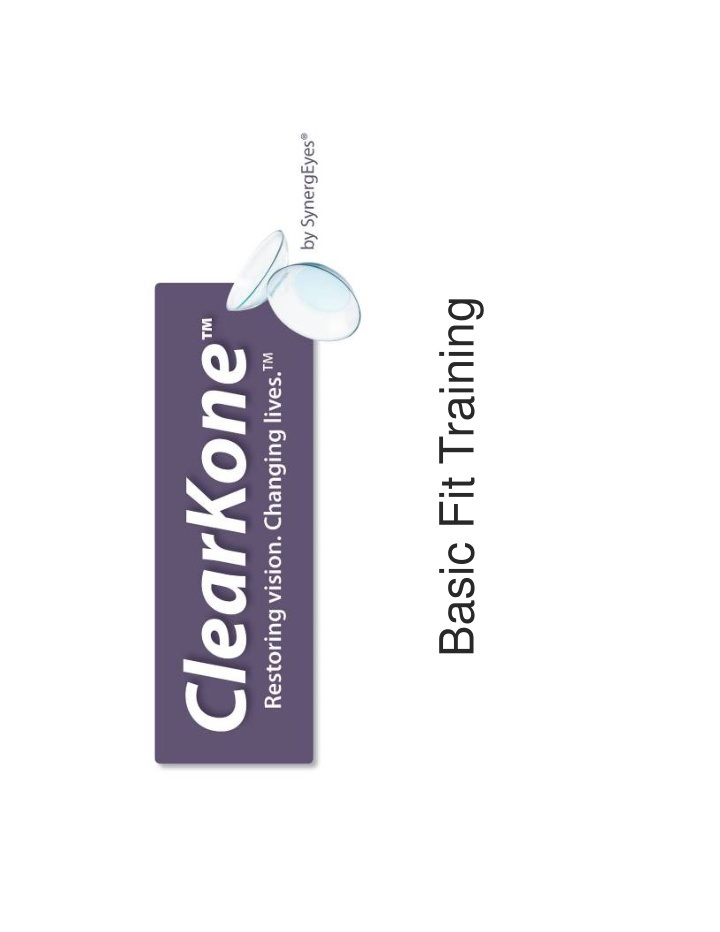



Basic Fit Training
Vault and Skirt Curvature ClearKone is available in 11 different vaults of which each can be ordered in 3 different skirt curvatures; flat, medium and steep. The vault diameter is ~7.4mm and includes the spherical optic zone and reverse curve The fit of the vault is independent of the fit of the skirt curve. Each should be fitted separately.
ClearKone Diagnostic Set 22 lens diagnostic set: 11 Vaults: 100 – 600µ in 50µ steps 2 Skirt Curvatures for each Vault: Medium and Steep DMV scleral cup inserter Each Dx lens has laser markings NaFL illuminating cobalt that indicate its lens type, vault pen light and skirt curvature Wratten filter
Ideal ClearKone Fit RGP/ SCL Apical Junction Clearance I LZ OLZ Thinning Bearing
Inserting the Diagnostic Lens Start with the 250µ Vault in the Medium skirt curve. Fill the bowl of the lens completely to the top with 1 drop of fluorescein and non- preserved saline. Have the patient lean forward and tuck their chin to chest. Nose should be perpendicular to the floor. Retract the upper and lower lids and gently place the lens on the cornea.
Check for Bubbles After Insertion Check for bubbles under the lens with the blue pen light included in the diagnostic set Bubbles cannot be displaced by lens manipulation – remove and re-insert
Timing the Fluorescein Evaluation IDEAL WAIT TIME 1 minute after insertion 3 minutes after insertion 7 minutes after insertion 16 minutes after insertion 31 minutes after insertion
Step 1: Determine Vault Evaluate the 250µ Vault in the Medium skirt curve. Central Pooling Central Bearing Vault too Shallow Vault too Deep
Step 1: Determine Vault I nitial Vault Too Shallow : I ncrease Vault in 1 0 0 µ Steps Until: Central Bearing Apical Clearance Reduce vault by 50µ and Becom es re-evaluate for apical clearance. I nitial Vault Too Deep: Decrease Vault in 1 0 0 µ Steps Until: Central Pooling Central Bearing Increase the vault by 50µ Becom es and re-evaluate for apical clearance.
Avoiding Over-Vault The most common source of failure with a ClearKone lens is over-vault Apical Clearance – Central Pooling - Pupil Visible Pupil Not Visible I LZ Bearing I LZ Thinning I deal Vault Over-Vault Sym ptom s of Over-Vault: Discom fort and Reduced W ear Tim e Several W eeks Post-Dispense
Step 2: Determine Skirt Curvature I deal Skirt Curve Fit Evaluate skirt only after OLZ proper vault is determined Bearing and is on eye Start with the Medium skirt I LZ GOAL: NaFL thinning in the Thinning ILZ and bearing in the OLZ. Lens will exhibit movement very similar to soft lens. RGP/ SCL Junction Patient comfort will greatly validate final fit
Skirt Curve too Flat – Example 1 If bearing observed under ILZ – steepen the skirt curve I LZ I LZ I LZ Bearing Thinning Bearing Steep Skirt Medium Skirt Switch To
Skirt Curve too Flat – Example 2 If bearing observed under ILZ – steepen the skirt curve I LZ I LZ I LZ Bearing Bearing Thinning Steep Skirt Medium Skirt Switch To
Skirt Curve too Flat – Example 3 I LZ Bearing OLZ Pooling If pooling observed under the OLZ, and bearing is observed under ILZ – steepen the skirt
Skirt Curve too Steep I LZ Pooling OLZ Pooling If pooling observed under the ILZ – flatten the skirt curve
Determining Proper Skirt Curvature NaFL Diffusing Beneath Junction Patient comfort is optimized when NaFL pattern shows slight diffusing beneath the rigid/soft junction
Step 3: Determine Final Lens Power When an ideal NaFL pattern is achieved, over-refract to determine final lens power If the over-refraction is greater than 4.00D, adjust for vertex distance. Lenses in the fitting set vary in power from -1.00D to -14.50D sphere power depending on the vault depth selection. - A laminated card is provided in the Dx set indicating the power of each lens
Corneal Change Goal of the fitting process for the ClearKone lens is to clear the cone If the previous lens was physically touching the cornea, it will “mold” the shape of the cornea - patients will likely have topographical changes once fit with ClearKone Fit looks deep enough on dispense and is comfortable, but as cornea changes fit will need to be adjusted Discomfort or reduced wear time at follow up indicates need to check for central bearing Typically only have to change vault and power Continued re-fitting will not be necessary – cornea will stabilize once it has returned to its natural shape For patients coming out of another lens, err on the side of deeper vault on original order – fit 100µ over first bearing
Where to start Fitting ClearKone is different than any other lens for irregular corneas – including SynergEyes KC - Commit to the learning curve After ~3-4 patient fits, the fitting process will go very quickly and be straightforward / predictable - Give yourself extra time initially Good patient candidates for first fits include: Newly diagnosed patients RGP patients wanting better comfort/acuity Piggybacks wanting improvements Failed SynergEyes KC patients
Congratulatoins! You have now completed the ClearKone Basic Training presentation. Your SynergEyes representative will contact you to discuss your options for obtaining a fitting set.
Recommend
More recommend